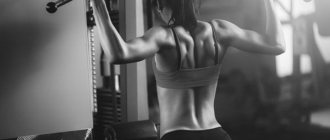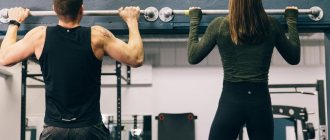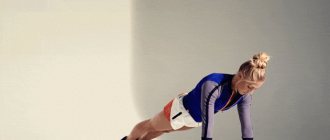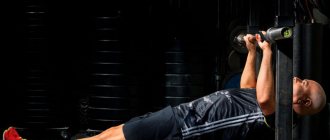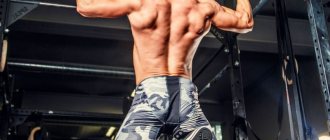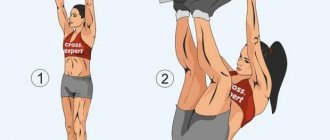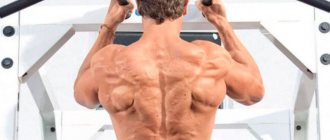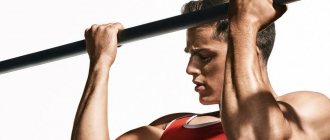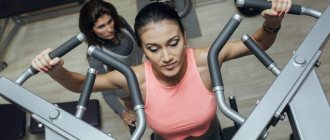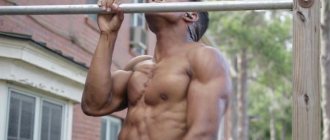The name “Australian pull-ups” was given to this exercise by the Americans. It corresponds to the slang name for Australia - “down there”. It is not known for certain who invented this wonderful exercise. But it has been used in physical therapy, children's gymnastics, crossfit and fitness training for many years. The movement will help develop the latissimus dorsi muscles for those who do not yet know how to do hanging pull-ups, or do it technically incorrectly - with swinging.
In gyms, the exercise is performed by fixing the Smith machine bar at a level below the athlete’s waist, or in a power rack, using a regular bar as a crossbar for support. You can also do the exercise on parallel low bars with a reverse grip or a specialized horizontal bar. The movement is sometimes performed in training loops, on gymnastic rings, or while hanging on a thick rubber shock absorber. This allows you to activate your back muscles a little differently, engage stabilizers, and reduce the load on your lower back.
Execution technique
Initial position
- The crossbar is installed at waist level, or slightly higher if a beginner is pulling himself up, and it is difficult for him to perform the movement from a lower position;
- It is necessary to fix the projectile so as to prevent it from falling;
- The grip is straight, slightly wider than shoulder width or adequate shoulder width;
- The body is straightened, the pelvis is tucked, the hip joint is extended, the muscles are tightened;
- The fingers clasp the bar, the palm lies on the bar;
- The abdomen is tightened and neutralizes excess deflection in the lower back
Movement
- Squeeze your shoulder blades toward your spine and move your shoulders away from your ears;
- Pull your chest toward the bar, continuing to squeeze your shoulder blades and tense your lats;
- Touch the bar, then lower your body back down;
- Contract your muscles as you exhale, lower as you inhale;
- Do the required number of repetitions, maintaining a straight body position and toned buttocks.
Attention
- A pause at the peak of the contraction will help you strengthen the latissimus muscles better and eliminate unnecessary movements;
- The descent should be relatively slow, simply relaxing your muscles and lowering yourself under the weight of gravity is a bad strategy;
- Upward jerks and pelvic thrusts are not allowed;
- It is necessary to turn off the legs as much as possible, do not involve the pelvis, hip joint and do not push with the legs
Horizontal pull-ups are a simple exercise for a powerful back!
Contraindications
Many believe that wide-grip pull-ups on the horizontal bar provide significant assistance in the treatment of intervertebral hernias, however, this is not entirely true.
Fortunately, back exercises are not limited to just pull-ups; now every modern gym is equipped with various block and lever exercise machines, on which you can work out the latissimus dorsi muscles no less effectively, and most importantly, without threatening your health.
However, before you start training your back, it is better to consult your doctor or a highly qualified instructor about how to replace wide-grip pull-ups. This could be vertical rows on a wide-grip cable machine, pull-downs on lever machines, or overhead pullovers.
Recommendations
- Rest your toes against a barbell plate or plyometrics box, this will help remove inertia and prevent slipping;
- Pull your chest to the bar; in terms of biomechanics, the movement is most similar to an inverted bench press; the exercise will therefore be useful for beginner benchers, and simply for those who want to learn how to engage their back muscles and press more;
- Stay at the top statically, this will strengthen your core muscles faster. The back is naturally quite strong, it just needs to be included in the work, statics will help the athlete progress and quickly move on to more complex exercises;
- Rise smoothly, and try to lower in 4 counts, that is, twice as slow;
- If you have problems with your grip, try to place your palm completely on the bar, make your grip deeper, and do not work in a manner that involves “extra” muscles in the movement;
- Do not try to tighten your biceps; working them is not the main purpose of parallel or horizontal pull-ups;
- Eliminate kicking off the ground to progress faster
How to make it more difficult
Over time, such pull-ups may seem like a very easy task, so already experienced athletes try in every way to complicate them in order to pump up their muscles even more. You can do this in different ways:
- choose a low crossbar for training (it is advisable to reduce its height gradually so as not to end up horizontally on the floor in the lowest phase of the exercise);
- place a high support under your feet: the higher the surface for support, the harder it is to pull your chest to the bar;
- pull yourself up with only one arm, moving the other behind your back or placing it on your side;
- lean on only one leg, placing the other on the supporting leg.
In addition, in the process of performing exercises, even a novice athlete can notice the most “heavy” angle of inclination of the body, and if in the initial stages of using Australian pull-ups they try to avoid it, then in the future it is precisely this “uncomfortable” position that will help pump up even more.
Variations
- Pull-ups with a narrow reverse grip . This movement involves more of the biceps and forearms due to its biomechanical nature. The exercise allows you to strengthen your arms and forearms in equal measure with your back, but does not contribute to long-term progress in the development of back muscles;
- Pull-ups with a narrow straight grip . They engage the serratus muscles and force the shoulders to work, but at the same time they work better on the latissimus;
- Australian wide grip pull-up . The most common option, which is used only for developing the lats. This option can be performed with either a forward or reverse grip, and involves the back most actively. Working out the back muscles will be even more active with a reverse grip, since the athlete’s elbows will automatically be pulled towards the waist;
- Pull-ups in training loops . This option is convenient because those who wish can include the rear bundles of deltoid muscles, as well as the latissimus dorsi muscles, in the work. Pull-ups in loops are well suited for those who are just starting to exercise, because you can stand close enough to the place where the projectile is attached and reduce the load so that it is optimal for a beginner. It is enough to perform the movement, pressing your forearms to the body, and you will achieve maximum activation of the latissimus dorsi muscles.
What muscles work
The Australian pull-up is one of the universal compound movements that is recommended for anyone who needs to use the maximum number of muscles in their work. This exercise is a complex multi-joint exercise.
Main engines:
- latissimus dorsi muscles;
- diamond-shaped;
- trapezoidal.
The biceps and forearms help with movement. The muscles of the legs, buttocks, and abs are involved as stabilizers.
Alternating grips changes the load on the muscles:
Wide straight grip:
- lats;
- diamond-shaped
Medium reverse grip:
- arm biceps;
- forearms;
- lats.
Narrow grip:
more significantly includes the forearms and biceps.
Analysis of the exercise
What muscles work
In programs for beginners, the exercise is included as one of the stages of preparation for the classic pull-up. The movement creates an athletic V-shaped torso. The exercise helps to activate not only the back muscles, but also the muscles of the forearms and palms, strengthens the grip, and prepares for all traction movements.
Working muscles:
- Latissimus and rhomboid muscles of the back;
- Trapezius and round muscles;
- Biceps and forearm muscles;
- Abs, buttocks, and leg muscles as stabilizers
Advantages
- Suitable for beginners. They are often the first horizontal row in terms of strength training, and allow you to learn not only how to work with your own weight, but also how to properly engage your back muscles. The movement is better for a beginner than pulling a barbell to the belt due to the fact that it eliminates even a static load on the thoracic spine and cannot cause a back injury;
- Australian pull-ups are good for rehabilitation. After an injury, this movement will help restore muscle tone, strengthen your back, and improve muscle function in general. The exercise does not create a torsional or compressive load,
- Australian pull-ups allow you to create a beautiful silhouette, are suitable for bodybuilding purposes, and can be used by intermediate athletes to pump up their back muscles at the end of a workout. The higher the legs, the greater the load on the lats, so the variation with the legs raised on the support allows even the advanced to get the load;
- Pull-ups on a low bar are ideal for women's training; they strengthen the muscles that are “lagging behind” in most women and eliminate postural disorders;
- The movement can be performed by children and teenagers, and does not require a gym membership; in any yard there is a horizontal bar on which you can successfully do pull-ups, and parallel bars or a ladder for honing the skill of Australian pull-ups.
Smith machine pull-ups: 3 difficulty options
Why are horizontal pull-ups needed?
- they act on the body comprehensively, they are necessary and simply necessary to strengthen the arms, back, shoulders;
- also strengthen ligaments;
- suitable for everyone - both beginners and experienced athletes;
- this is work with your own weight, which fits perfectly into any workout;
- in this training you simply learn to feel your back muscles, create some kind of your own muscle base;
- they can be safely used both as a warm-up and as the final stage of training;
- muscle activity here is 60% greater than when pulling a barbell in an inclined position;
- such pull-ups do not require a very strong lower back and flexibility in the posterior thigh muscles;
- Such pull-ups are quite safe and can be done even if you have spinal problems.
By the way, an alternative to the crossbar can be: a low horizontal bar, a bar, rings, TRX loops. Rings that sway slightly will provide additional training opportunities.
Preparing for the exercise
Unlike the classic hang, which is inaccessible if you have limited mobility in the shoulder joint, this version of the exercise is accessible to everyone. Before starting your workout, you need to warm up, do a general cardio warm-up, a joint warm-up, and 1-2 sets of pull-ups using a lightweight technique.
For this, beginners can use an almost vertical stance on the ground and a high support, continuing the usual technique, but without a pause at the top.
The exercise can be included not only as the first back movement, but also at the end of the workout, in which case it can be performed after the other movements have been done. Then joint warm-up is not necessary.
For beginners, it makes sense to do 1-2 sets of push-ups at the beginning of parallel grip pull-up training. The idea is that the inclusion of antagonist muscles contributes to better functioning of the back muscles.
Proper execution
- It is important to keep your spine and legs straight. The knees do not need to be “pushed” forward, they should remain in a neutral position so that the ligaments do not experience discomfort;
- The height of the bar cannot be the same for all people. The average starting position is at waist level, and most people should perform the movement from there. But for beginners, higher bars are also suitable, and for intermediates and those who are trying to correct their posture, pull-ups literally from a lying position on the floor;
- The one who performs it technically correctly is the one who feels the contraction of the shoulder blades to the spine, and consciously brings them together, and does not simply bring the body with the biceps to the bar;
- The starting point of the exercise is characterized by emphasis on the heels, but if the athlete’s hamstrings experience discomfort, standing on the foot with pointed toes, or using various types of supports is allowed;
- Exhale while pulling up, inhale while slowly lowering the body down;
- You need to strive to ensure that both halves of your back work equally, with your forearms parallel to each other. This will promote equal muscle involvement and help you move actively.
Errors
- Work in terms of amplitude, lack of involvement of the back muscles in the work due to pushing with the legs;
- Bend your knees and push your pelvis towards the bar;
- Uneven movement, that is, pulling with one arm and half of the back;
- Retracted shoulder blades at the moment of peak contraction;
- Lack of rigid fixation of the feet, “riding with feet”;
- Holding your breath during exercise;
- Haste and careless pace
Efficiency Tips
- Use a knurled grip and chalk if allowed in the gym. This will help avoid slipping while moving;
- The narrower your feet are, the more you have to involve the latissimus muscles in the work, and the harder you have to pull yourself up;
- Experienced athletes should aim for a parallel hang on the bar, and therefore keep their feet at a decent height
Important: Experienced athletes may lean on their calves rather than their feet. This emphasis reduces the efficiency of the legs and transfers the load to the back, which is what this exercise requires.
- Adjusting the load is quite simple. The closer the spine is to the plane of the floor, the more effective the work of the latissimus dorsi muscles. Therefore, in the gym, the pull-up bar or bar should be set as low as possible;
- In the gym, you can use not only footrests, but also straps to increase the range of motion by relieving the load on your forearms and palms. It makes sense to put on straps when the grip weakens
Note: this exercise can be performed in TRX loops, and then it will help not only strengthen the muscles of the back and arms, but also learn to stabilize the body. In this version, the movement also takes on additional meaning as an exercise for the ligaments.
Inclusion in the program
Negative pull-ups are performed on a separate day.
If your goal is to learn pull-ups, you should not train your back with other vertical rows that day. You can supplement this workout with rotator cuff work, barbell or dumbbell biceps curls, and 1-2 horizontal back rows if the athlete can handle that kind of volume. Pull-ups are the first exercise of the plan, and are placed at the end only if the athlete is experienced, knows how to do pull-ups, and does negatives with weights as an additional movement, which is designed to develop the strength of his lats and forearms;
If the goal is to learn to do pull-ups, at the beginning of each workout the athlete tries to do a pull-up on his own, without the help of a partner and not from a jump. If he succeeds, he performs as many reps as he can, rests for 5-10 minutes, and begins the negatives.
Very often, beginners’ grip fails, so it’s worth using the most non-slip horizontal bar, applying magnesium to your hands, and fixing your hands with straps if there is no other way to stay hanging long enough.
For the purposes of learning pull-ups, 3-4 sets of negatives with 30-40 seconds under load each set are sufficient. This will help the athlete develop both grip and muscle strength.
If you fail to learn despite regular training, you should pay attention to your posture in general. Shoulders pulled forward often make it difficult to pull yourself up
Working on the diamond, lat and rear deltoids solves these issues.
Don't know how to do pull-ups? Just Watch This!
Watch this video on YouTube
How to do it: Raising your torso from a supine position
Raising the body from a supine position is performed from the starting position: lying on your back, on a gymnastic mat, hands behind your head “locked”, shoulder blades touching the mat, legs bent at the knees at a right angle, feet pressed by a partner to the floor.
The participant performs the maximum number of body lifts in 1 minute, touching the hips (knees) with the elbows, followed by returning to the starting position. The number of correctly performed body lifts is counted.
The test is performed in pairs. Alternately, one of the partners performs the test, the other holds his legs by the feet and (or) shins. If there is specialized licensed equipment for fulfilling the testing standards of the GTO complex, the participant can hold the legs in a special groove of the sports equipment independently.
Errors
Errors in which execution is not counted:
- no elbows touching the hips (knees);
- no contact of the shoulder blades with the mat;
- opening the fingers “from the lock”;
- pelvic displacement (pelvic elevation)
- changing the right angle of bent legs.
Wide head grip
Another common and quite popular variation of this exercise. The main nuance that you should remember when performing this version of pull-ups is that it is quite traumatic. Risk arises from incorrect execution. If the shoulder joints remain immobile, a very serious injury can occur. The load falls on the same muscle groups as when pulling with a wide grip to the chest, but the latissimus dorsi muscles are worked the most.
The width of the grip is similar to that of the bench press. When doing this exercise, you should under no circumstances bend your back. The body and legs should form an even, single line. The elbows must be kept pointing downwards at all times. They shouldn't look back. At the highest point, the neck should not come into contact with the surface of the crossbar.
Until the full range of movement is achieved, you need to spend a certain amount of time training. This allows you to master the correct technique. If you try to do a pull-up right away, you may get injured. A signal to stop further movement is pain in the back or shoulder joints. You can't stop moving suddenly. It is necessary to slowly lower to the starting position. This will avoid injury or minimize damage.
Hanging on the abdominal bar
The horizontal bar is a very versatile piece of equipment that can be used not only for pull-ups or stretching of the spine, but also for training the abdominal muscles. The usual crunches and planks are undoubtedly very effective exercises for the abs, but hanging leg raises on the horizontal bar will also help you achieve that coveted six-pack.
- To perform this exercise, grab the bar with your hands and bring your legs together. Then raise your legs straight in front of you to a 90-degree angle.
- Don't let your knees bend as you lift your legs. If you cannot raise your legs to parallel with the floor, raise them to a comfortable height for you.
- Move slowly so as not to use momentum and swing. Making jerks will not allow you to fully feel the work of your abdominal muscles, and the exercise will be useless and even dangerous.
There are many variations of this exercise: with bent knees, each leg in turn, or you can raise your legs all the way to the bar. Depending on your fitness level, choose the option that's right for you. The benefits of lifting your legs while hanging on a horizontal bar are really great. Be sure to try this exercise at your next workout.
How to do it: bending and straightening your arms while resting on a gymnastic bench
In the age group of 60-69 years (X stage), men perform flexion and extension of their arms while resting on a gymnastic bench; in the age group of 70 years and older (XI stage of the GTO standards) - on a chair seat.
The remaining requirements for performing tests and avoiding errors are similar to the requirements of the test “Bending-extension of the arms while lying on the floor.”
Testing is carried out in a gymnastics (sports) hall or on a universal sports ground. The testing area must be fenced off with tape so that no one interferes with the test taker in achieving the maximum result.
Bending and extension of the arms in a lying position is performed from the starting position: lying on the floor, arms shoulder-width apart, hands forward, elbows spread no more than 45 degrees relative to the body, shoulders, torso and legs form a straight line. The feet rest on the floor without support.
The number of correctly performed cycles consisting of flexion and extension of the arms, recorded by the judge’s counting out loud or using special devices (electronic contact platforms), is counted.
Bending your arms, you need to touch your chest to the floor or a contact platform 5 cm high, then, straightening your arms, return to the starting position and, having fixed it for 1 second, continue performing the test.
Errors
Errors that result in the test not being counted:
- violation of the requirements for the initial position;
- violation of test technique;
- violation of the straight line “shoulders - torso - legs”;
- lack of fixation for 1 second in the initial position;
- exceeding the permissible angle of elbow extension;
- multi-simultaneous extension of arms.
